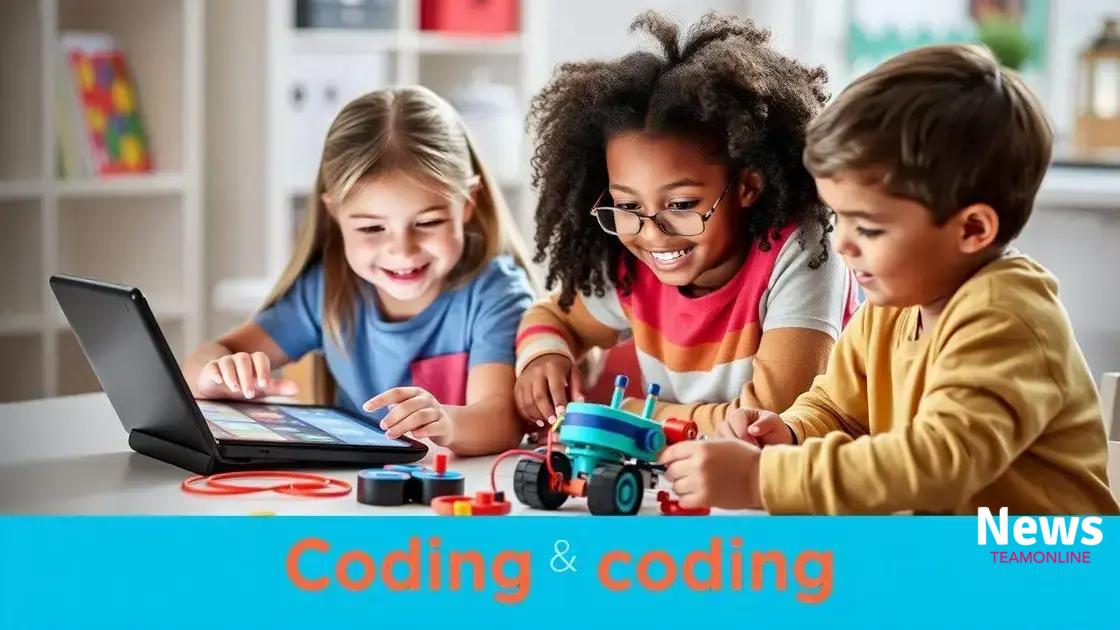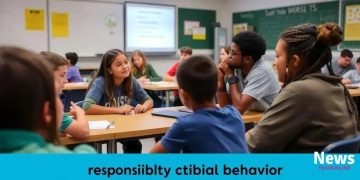Coding for kids: introducing programming at an early age

Teaching coding for kids is essential as it fosters critical thinking, creativity, and prepares them for future technology-driven careers through engaging resources and supportive learning environments.
Coding for kids is more than just a skill—it’s a vital part of modern education that cultivates creativity and analytical thinking. Have you considered how programming can empower your child?
Why teaching coding is essential today
Teaching coding is essential today because it fosters creativity and critical thinking in young minds. As our world becomes more digital, understanding programming equips kids with valuable skills for the future.
Benefits of Learning Coding
Coding offers numerous benefits that go beyond just writing programs. Kids learn how to break down complex problems into smaller, manageable parts. This skill is crucial for many aspects of life. Furthermore, coding promotes logical thinking and helps children understand the organizations behind the technology they use every day.
- Encourages problem-solving skills
- Enhances creativity through project-based learning
- Prepares children for future careers
- Boosts confidence by completing projects
Additionally, coding aids in developing persistence. When kids face challenges in coding, they learn the importance of trying different approaches until they find the solution. This resilience is a key factor in their overall growth.
Real-World Applications
Understanding coding opens the door to various career opportunities. Many industries today rely on technology and programming skills. From game development to web design, the possibilities are endless. Children with coding skills often excel in fields that require analytical thinking and creativity.
Furthermore, learning to code doesn’t just prepare children for tech careers. It also equips them with foundational skills applicable in numerous fields. For instance, data analysis and project management benefit greatly from an understanding of programming principles.
In conclusion, teaching coding today is a gateway to success in both personal and professional life. As technology continues to advance, the ability to understand and create software will become even more vital.
Best programming languages for kids
Choosing the right programming languages for kids can make learning to code fun and engaging. Some languages are particularly well-suited for beginners, offering features that help young learners grasp coding concepts easily.
Scratch
Scratch is a great starting point for kids ages 8-16. It uses a block-based coding system that allows children to create animations, games, and interactive stories. The visual interface makes it easy to learn coding fundamentals without the hassle of syntax.
- Encourages creativity through interactive projects
- Teaches problem-solving skills with game design
- Has a large online community for sharing projects
This makes Scratch not only a learning tool but also a platform for creativity and collaboration.
Python
Python is another excellent choice for kids. It’s known for its simple and readable syntax, making it suitable for young learners after they get comfortable with block-based coding. Python is also versatile and widely used in real-world applications.
Kiddos can start with simple projects like making a calculator or a basic game. This begins to build their confidence as they see their code in action and encourages deeper exploration into programming concepts as they grow.
Blockly
Blockly is similar to Scratch and is another great visual programming language. It allows kids to build applications by assembling blocks of code visually, which helps in developing their logical thinking.
Kids can easily switch from Blockly to JavaScript or Python, providing a smooth transition to more complex coding languages when they are ready.
JavaScript
JavaScript is essential for web development and is increasingly taught to kids interested in creating websites. Kids can see immediate results when they adjust code, making it rewarding and exciting. By using JavaScript, they can learn how to implement basic interactivity on web pages.
Overall, selecting the right programming languages is crucial for fostering a love for coding in children. Each language has unique features that can make learning to code enjoyable and effective.
Fun coding activities and games

Engaging kids in coding activities and games can make learning fun and exciting. Using a hands-on approach encourages creative thinking and problem-solving skills. Different games and activities are specifically designed to teach coding concepts while keeping children entertained.
Interactive Games
Games like Code.org and LightBot provide entertaining ways for kids to learn programming fundamentals. These interactive games require players to solve puzzles and navigate challenges using coding commands, which enhances their understanding of logic and sequencing.
- Code.org offers lessons featuring popular characters from games and movies.
- LightBot introduces kids to basic programming logic through a fun maze-solving concept.
- These games keep children motivated and encourage them to think critically.
Incorporating technology in a playful way makes learning to code less intimidating and more accessible.
Building Projects
Another enjoyable activity is project-based learning. Kids can create their own games or animations using tools like Scratch. This not only teaches them valuable coding skills but also allows them to express their creativity.
Projects give children a sense of ownership and accomplishment. They can share their creations with friends and family, which adds to their motivation.
Robotics and Unplugged Activities
Robotics is a fantastic way to blend coding with hands-on activity. Using kits like LEGO Mindstorms or VEX Robotics, kids can build and program their robots. This activity brings concepts to life and showcases how coding can influence the physical world.
Unplugged activities are just as important. Activities like coding board games teach programming concepts without a computer. Games such as Robot Turtles and Code Monkey introduce core principles of coding while allowing kids to play together.
Creating a fun learning environment can ignite an interest in programming early on, paving the way for future exploration in technology.
Resources for parents and educators
Having the right resources for parents and educators can significantly enhance the experience of teaching coding to kids. Many of these resources are designed to support both teaching and learning programming concepts effectively.
Online Platforms
Websites like Khan Academy and Codecademy offer free interactive courses where both parents and educators can learn alongside children. These platforms have user-friendly interfaces and provide lessons in coding, making it simple for beginners.
- Khan Academy focuses on foundational concepts through engaging videos and exercises.
- Codecademy allows users to practice coding in real-time with instant feedback.
- Both platforms encourage a hands-on approach, fostering a love for coding.
These resources ensure that learning is not just a solitary experience but a shared journey.
Books and Guides
Books such as “Python for Kids” and “Scratch Programming Playground” provide valuable insights for teaching coding concepts in a fun way. They offer step-by-step instructions, projects, and illustrations that make understanding coding both engaging and educational.
Parents can use these guides to explore coding at home, while educators can implement them in a classroom setting.
YouTube Tutorials
YouTube is a treasure trove of coding tutorials, with channels dedicated to teaching kids how to code. Channels like Code.org and Coding Train offer lessons through fun and exciting methods, appealing to young learners.
These video tutorials make complex coding concepts relatable and easy to grasp. Kids can follow along at their own pace, helping reinforce what they learn.
Community and Forums
Joining online communities and forums is another excellent way for parents and educators to gather insights and support. Websites like Stack Overflow and Reddit have active coding communities where questions can be asked, and experiences shared.
Connecting with other parents and educators allows them to exchange tips, resources, and encouragement, all of which can make the coding journey more enjoyable.
How to create a supportive learning environment
Creating a supportive learning environment for coding is essential for children to thrive. A positive atmosphere can inspire kids to explore and enjoy the process of learning. Several key strategies can help establish this environment.
Encouragement and Praise
It’s important to regularly offer encouragement and praise. Kids learn best when they feel supported. Recognizing their efforts, regardless of the outcome, helps build their confidence. Simple phrases like “You did a great job!” or “I love how you solved that problem!” can boost their motivation.
- Use specific feedback to highlight what they did well.
- Encourage them to take risks and embrace mistakes as learning opportunities.
- Create a culture where trying is more important than immediate success.
This nurturing feedback encourages children to keep trying new things.
Collaborative Learning
Organizing group activities promotes collaborative learning. Working together allows kids to share ideas and tips. Pair programming, where two students work together on a coding task, encourages communication and teamwork.
Having a buddy system can also be beneficial, where they support each other during challenges. This collaboration reinforces their learning and creates a sense of community.
Accessible Resources
Providing access to various resources is vital for a supportive environment. Consider having a range of materials like coding books, tutorials, and online courses. Access to these resources helps cater to different learning styles.
Utilizing platforms where kids can showcase their projects, such as Scratch or GitHub, gives them a sense of ownership. When they can share their work with others, it reinforces their skills and builds pride in their accomplishments.
Creating a Comfortable Space
The physical space can significantly impact learning. A comfortable, dedicated area for coding can help children focus and engage more deeply with the material. Make sure the space is free from distractions and has all necessary tools, such as computers and gadgets.
Incorporating elements like colorful posters, whiteboards for sketching ideas, and soft seating contributes to a friendly atmosphere that encourages creativity. Overall, a supportive learning environment fosters growth, creativity, and a love for coding.
FAQ – Frequently Asked Questions About Coding for Kids
Why is it important for kids to learn coding?
Learning coding teaches kids critical thinking and problem-solving skills. It also prepares them for future careers in a technology-driven world.
What are some beginner-friendly coding languages for kids?
Scratch and Python are excellent choices for beginners. Scratch uses block-based coding, while Python offers simple syntax that is easy to learn.
How can I make coding fun for my child?
Incorporate fun coding games and projects, engage in collaborative activities, and praise their efforts to boost their interest and motivation.
What resources can I use to support my child’s coding journey?
Online platforms like Khan Academy and Codecademy, as well as books and YouTube tutorials, are great resources to help kids learn coding interactively.





